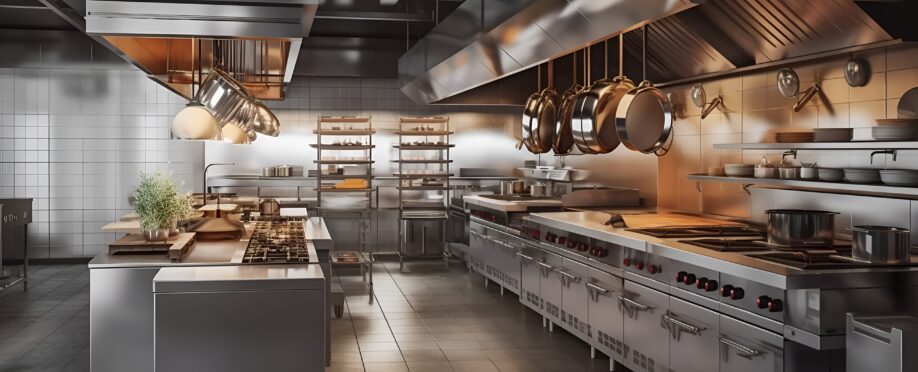
Amid rising costs for labor, food, and real estate, restaurant facility management has a tough time competing for priority on the C-suite’s crowded agenda. Yet it plays a crucial role in restaurant and brand success, from keeping kitchen equipment running to presenting a comfortable, clean and inviting environment for customers. Here are five common restaurant facility challenges and solutions that offer opportunities to boost operational efficiency and profitability that could attract executive attention.
Challenge #1: Avoiding Costly Equipment Breakdowns
Whether it’s refrigeration, cooking, or HVAC equipment problems, the costs of breaking down add up fast in a busy restaurant. Restaurant equipment failures can quickly lead to extended kitchen downtime, spoiled food, and unhappy customers. As one restaurant manager puts it: “If the equipment isn’t working, you ain’t cooking.”
Solution: Implement a Preventive Maintenance Program
Regular inspections and servicing can help identify potential restaurant equipment issues early, reducing downtime, emergency repair costs, and extending the lifespan of equipment.
“From a restaurant facility perspective, your equipment uptime underpins everything you do — it determines whether or not you make money that day,” says Richard Nuttall, President of City Consulting Services (CCS), which specializes in optimizing businesses’ facilities management performance. “In restaurants and foodservice, equipment performance is paramount.”
In restaurants and foodservice, equipment performance is paramount.Richard Nuttall, President of CCS
Considering that U.S. restaurants and food service companies spent a record $14.2 billion on equipment in 2022, investing in regular maintenance just makes sense. In an industry where unplanned downtime is unacceptable, restaurants can’t afford to wait until equipment breaks down. Restaurant facilities management needs to focus on preventive maintenance as opposed to reactive maintenance.
An effective preventive maintenance plan includes:
- Regular inspections based on equipment manufacturer guidelines and detailed checklists
- Scheduled maintenance prioritized by the importance of the asset to daily operations and timed to minimize disruption to protect food inventory, performance, and customer service
- Goals and KPIs to measure the success of your preventive maintenance plan and identify problem areas for improvement
Challenge #2: Hiring, Training and Retaining Restaurant Facilities Technicians
Having reliable equipment that keeps your restaurant cooking with great food and satisfied customers comes down to the skills and quality of your technical staff. But with so much focus on kitchen and service staffing, a restaurant company’s recruiters may not have a solid understanding of what it takes to find and compete for qualified restaurant facilities technicians.
Multiple factors can make recruiting and hiring qualified technicians even more complex and challenging than the labor shortage restaurants already face in kitchen and service staffing. And with restaurant equipment becoming more technically complicated, it’s harder to keep existing technicians trained and up to speed.
Solution: Put Effective Technical Workforce Development Frameworks in Place
Restaurant companies can get ahead of facilities management staffing issues with smart hiring and training strategies, says Tamara Joiner, Senior Vice President of People & Safety at CCS.
For example, restaurants can save time and recruitment costs by focusing more on developing and retaining the people they already have. “Often, a location has capable individuals who are adept at handling repairs, but they’re not certified or trained to a standard,” says Tamara, who oversees strategy for shaping culture, talent acquisition, engagement and development in addition to health and safety for City US and its consulting initiatives.
High-quality technician training involves developing customized programs with hands-on exercises. For example, CCS helps address a restaurant’s unique technician needs by creating custom training programs delivered at First Coast Technical Academy, their dedicated training center based in Jacksonville, FL. These trainings use the exact or similar equipment and scenarios that technicians will encounter at restaurant locations in the field.
Challenge #3: Driving Down Energy Costs
Restaurant operations are highly energy-intense, averaging a rate of energy use that’s five to seven times per square foot more than other commercial buildings, according to the U.S. ENERGY STAR program.
High-volume quick-service restaurants can even use as much as 10 times more energy per square foot. For example, a typical electric deep fat fryer uses more than 18,000 kilowatt-hours (kWh) annually, compared to the 12,000 kWh used by an entire average U.S. household. With energy prices increasing faster than the rate of inflation, eliminating energy waste caused by inefficient kitchen, lighting, and HVAC equipment is a growing priority for restaurant facility managers.
Solution: Increase Energy Efficiency Across Restaurant Operations
The best first step to improving restaurant energy efficiency is to conduct an energy audit on your facility. This will help you identify energy-saving opportunities so you can begin to weigh costs and benefits. Unlike labor and supplies, energy is a cost that can be strategically reduced without risking the loss of sales or employee and customer comfort.
Restaurant energy audits have shown that better equipment maintenance and no cost or low-cost implementations could realize energy savings up to 20 percent. With retrofits, employee training, and active energy management, restaurants can achieve even more savings, up to as much as 40 percent.
There’s no shortage of ways to save energy in a restaurant. Here are just a few examples that will deliver significant energy savings:
- Repair and maintain equipment: A leaky gasket, clogged burner, or missing control knob may not waste much energy individually, but when you combine all three, the energy costs add up. Use checklists to stay on top of repairs and maintenance.
- Cut idle time: Keeping equipment running when you’re not using it costs money. Implement startup/shutdown guidelines for ovens, fryers, griddles, steamers, and other kitchen equipment based on needs. Whenever possible, turn off back-up equipment during slow periods.
- Upgrade to energy-efficient equipment and lighting: Look beyond the sticker price when purchasing new equipment to consider energy use costs over the lifetime. Specifying ENERGY STAR-certified equipment over a portfolio of locations can save large chains thousands in annual energy costs.

Challenge #4: Preventing Health and Safety Problems
Nothing can destroy a restaurant’s brand image and sales faster than foodborne illnesses or health code violations. Fast-paced restaurants are high-risk environments when it comes to the health and safety of both customers and employees. And with the power of social media to destroy hard-earned reputations overnight, the risks have never been higher.
Solution: Prioritize Health and Safety Checklists, Training, and Inspections
Ensuring the health and safety of employees and customers, along with full regulatory compliance, is the most critical responsibility of restaurant facility management, and it should be shared by every staff member. Yet in the rush of day-to-day operations, health and safety can too easily be viewed as a routine compliance issue.
From fire safety, ventilation, and facility cleaning to proper food handling, storage and hygiene practices, facility managers need to collaborate closely with kitchen and service team management.
Key focus areas for health and safety include:
- Creating health and safety checklists
- Regularly training staff on safety protocols
- Conducting both routine and surprise inspections
- Maintaining clear records of safety checks and certifications to ensure compliance with regulations
Challenge #5: Managing Waste
With food costs accounting for 28% to 35% of restaurant sales and U.S. restaurants generating 11.4 million tons of food waste annually, reducing that waste represents a serious opportunity to boost profitability, according to the National Restaurant Association. In fact, for every dollar invested in food-waste reduction, restaurants could reap as much as $8 in cost savings.
Solution: Implement a Comprehensive Waste Management Program
It takes buy-in from up, down, and across a restaurant’s org chart to successfully tackle waste, from the executive office and facility management team to the supply chain and inventory pros and kitchen staff. To get the level of commitment and culture changes needed, waste experts recommend pitching food-waste reduction initiatives in such a way as to emphasize management efficiency and cost savings in addition to environmental and community benefits.
Effective restaurant waste management will include:
- Instilling a culture of waste prevention, from food to supplies
- Getting the data you need to track waste, relevant costs, and measure results
- Using inventory management and production planning to reduce shrinkage and food loss
- Partnering with waste management companies, including those specializing in recycling, composting, and safe and efficient disposal for all waste products, from grease and food to other disposables.
- Working with community nonprofit organizations to donate surplus food to feed hungry people
Tackle Restaurant Facilities Challenges with Confidence
It takes a strategic approach and a commitment to continuous improvement to address the many facilities management issues facing restaurants today. By implementing proven solutions, restaurant owners can enhance operational efficiency, reduce costs, and provide a better experience for both staff and customers.
Restaurant facilities teams typically run very lean operations. When you’re looking to leverage external expertise, City Consulting Services (CCS) offers 40 years of facilities management experience and maximum flexibility. Whether you’re seeking asset management, capital replacement, or technical workforce strategies, we’ll help you develop proven processes to maximize performance — and we can even help you implement them.

 2016: City US is established in North America, in partnership with Southeastern Grocers (SEG), servicing over 750 supermarkets across 7 southern states.
2016: City US is established in North America, in partnership with Southeastern Grocers (SEG), servicing over 750 supermarkets across 7 southern states. 1985: Willie and Susan Haughey establish City Refrigeration Holdings (UK) Ltd in Glasgow, UK.
1985: Willie and Susan Haughey establish City Refrigeration Holdings (UK) Ltd in Glasgow, UK. 2009: City Australia launches in Melbourne, in partnership with Coles, servicing over 700 supermarkets across the country.
2009: City Australia launches in Melbourne, in partnership with Coles, servicing over 700 supermarkets across the country. 2015: City Asia launches in Kuala Lumpur, Malaysia, in partnership with Dairy Farm, servicing over 205 supermarkets across the region.
2015: City Asia launches in Kuala Lumpur, Malaysia, in partnership with Dairy Farm, servicing over 205 supermarkets across the region.